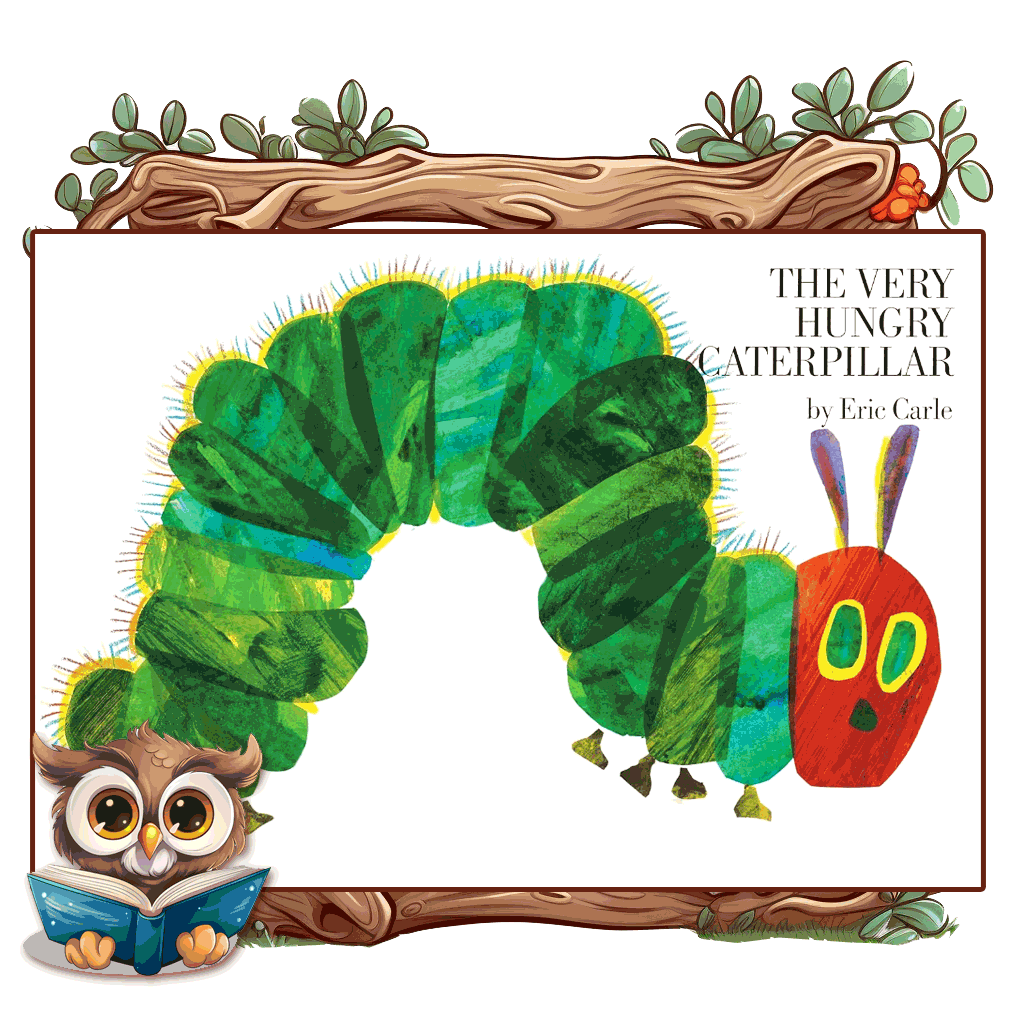Free Lesson: The Hungry Caterpillar

Quick Summary of The Hungry Caterpillar
“The Very Hungry Caterpillar” is a classic children’s book by Eric Carle, first published in 1969. In a nutshell, the story follows a newly hatched caterpillar as he embarks on a journey of eating various types of food over a week. The caterpillar eats through an increasing quantity of fruits each day, indulges in a variety of foods on Saturday, and then experiences a stomachache. Finally, he builds a cocoon around himself, emerging as a beautiful butterfly. The book is renowned for its distinctive collage illustrations and simple yet educational narrative.
Read or Watch The Hungry Caterpillar
Free Worksheets for The Hungry Caterpillar
Activity 1: Butterfly Cycle Coloring Book
Objective: To teach children about the life cycle of a butterfly, which is a key theme in the story.
Worksheet: This complimentary booklet on the Butterfly Cycle offers an exceptional learning experience, tailored specifically for young minds eager to explore the wonders of nature. By engaging with this resource, students embark on a journey to discover the fascinating lifecycle of the butterfly, creating a personalized book that serves not only as a learning tool but also as a cherished keepsake. Through the process of coloring each page, they will not only bring the vibrant world of butterflies to life but also hone their writing skills, deepen their understanding of book and writing concepts, and expand their vocabulary. This educational adventure is perfectly suited for students in prekindergarten, kindergarten, and first grade, providing them with a hands-on, interactive way to explore the miraculous transformation of butterflies. It’s an ideal blend of creativity, learning, and fun, making it an invaluable addition to any early childhood education curriculum.
Activity 2: Butterfly Cycle Stages: Egg, Caterpillar, Cocoon, and Butterfly
Objective: Label and understand the four stages of the Butterfly Life Cycle: Egg, Caterpillar, Cocoon, and Butterfly.
Worksheet: Following a delightful reading session of “The Hungry Caterpillar,” take the opportunity to enhance your child or student’s understanding and retention. Engage in a thoughtful discussion about the narrative and the transformative journey of the caterpillar depicted in the story. This conversation sets the stage for a deeper exploration of the lifecycle, introducing the four pivotal stages: egg, caterpillar, cocoon, and butterfly.
To solidify this newfound knowledge, present them with a specially designed worksheet that not only reinforces these concepts but also aids in the development of their fine motor skills. As they immerse themselves in coloring activities and practice printing alphabet letters, they’ll not only enjoy a creative outlet but also work on improving their handwriting. This multifaceted approach ensures that, along with enhancing their dexterity, they’re also expanding their vocabulary.
Activity 3: The Hungry Caterpillar Calendar Worksheet

Objective: Have the students work on their listening comprehension and their fine motor skills.
Worksheet: Following the engaging experience of watching “The Hungry Caterpillar” on YouTube or enjoying a read-aloud session with an adult, present the children with a carefully crafted worksheet. This activity is not just about coloring each of the delectable food items that our caterpillar friend devours; it’s a comprehensive exercise designed to bolster both comprehension-listening skills and fine motor coordination.
The task at hand involves cutting out the days of the week and thoughtfully pasting them into their corresponding boxes, matching them with the specific foods the caterpillar ate on those days. This interactive approach does more than just reinforce the story’s sequence; it actively involves the student in a hands-on learning process. By engaging in this cutting and pasting activity, children will not only revisit the story’s plot but also enhance their ability to follow auditory directions and improve their precision and dexterity.
This worksheet is an excellent tool for educators and parents looking to cultivate listening comprehension and fine motor skills in a fun, story-based format. It’s an inventive way to deepen the understanding of the story’s progression while simultaneously developing important educational skills.
Activity 4: The Hungry Caterpillar Color and Number Puzzle

Objective: Have the students work on their fine motor skills through coloring and number counting.
Worksheet: After immersing themselves in the delightful tale of “The Hungry Caterpillar” through either a captivating YouTube video or an engaging read-aloud session with an adult, children can further explore the story’s themes and characters with a thoughtfully designed worksheet. This worksheet presents an interactive and educational opportunity for young learners, encompassing various activities aimed at enhancing their cognitive and motor skills.
One of the activities included in the worksheet involves coloring butterflies and the caterpillar, which not only allows children to express their creativity but also serves as a means to develop their fine motor skills. As they carefully fill in the colors and stay within the lines, they refine their hand-eye coordination and dexterity. Additionally, this coloring activity aids in visual comprehension, as children observe the colors and patterns associated with different elements of the story, reinforcing their understanding of the narrative.
Another engaging task in the worksheet is a puzzle activity where children arrange the pieces in order, representing the sequence of events in the story. This activity is particularly beneficial for students who are learning their numbers, as they correlate each piece of the puzzle with a specific numeral, thereby reinforcing numerical recognition and sequencing skills. Moreover, the process of arranging the puzzle pieces entails fine motor movements, as children manipulate and place the pieces in the correct order, further honing their manual dexterity.
Overall, this carefully crafted worksheet not only serves as a fun extension of the “Hungry Caterpillar” experience but also provides valuable learning opportunities. Through activities such as coloring, puzzle-solving, and sequencing, children engage in meaningful tasks that promote cognitive development, fine motor skills, and visual comprehension, making learning a playful and enriching experience.


